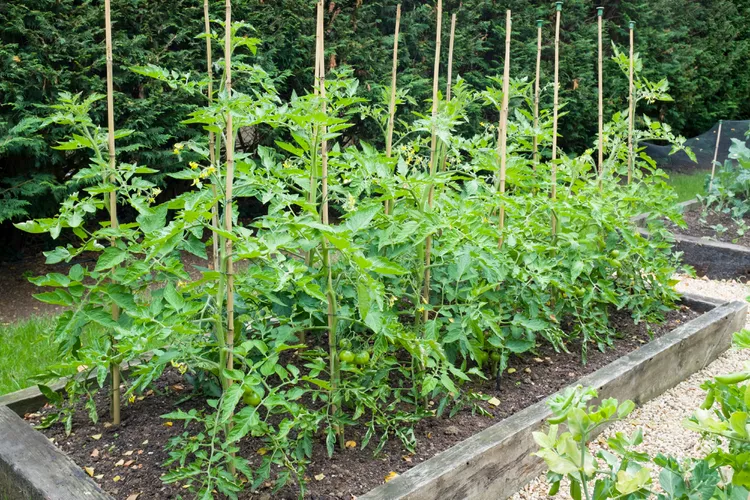How Far Apart to Plant Tomatoes: 7 Tips for the Right Spacing

A tiny tomato seedling grows exponentially in just a couple of months. And when you've got several seedlings, you need to know how far apart to plant tomatoes in your garden so they all can reach their full potential. Getting the spacing right results in healthier, more productive plants and an easier harvest—you won't have to fight through a jungle of stems to pluck a ripe fruit. Use the following tips to help you figure out how far apart to space your tomato plants, depending on the type.
1. Know Your Tomato Plant
Tomato plant spacing depends on the type of tomato. Tomatoes plants are in one of two groups based on their growth habit: determinate or indeterminate. Determinate varieties are smaller, compact plants that grow to a certain height, stop, then flower, and set all their fruit in two to three weeks. Indeterminate plants grow, flower, and fruit for months until they are killed by frost.
Compact determinate tomato varieties, such as ‘Patio’, require much less space than a vigorous indeterminate grape tomato, such as ‘Valentine’. If you don’t know whether your variety is determinate or indeterminate, see the plant tag or check online sources.
2. Don't Crowd Determinate Tomatoes
Most paste varieties, patio, and compact selections, and some slicing tomatoes are determinate. These cultivars fruit best when planted 2 to 2 ½ feet apart. Even though they need just 2 to 3 feet between plants to grow well, they need the full amount of space. Don’t be tempted to skimp on spacing to squeeze in more plants, or disease will become more prevalent, and fruit production will suffer.
3. Cage or Stake Indeterminate Tomatoes
Many grape and cherry tomato varieties, along with most heirloom tomatoes and some slicers, are indeterminate varieties. These types of tomato plants naturally sprawl on the ground as they grow, which requires more space, and disease is more common because plants are constantly in contact with the soil.
Cage or stake tomato plants to grow them in less space and keep them healthier. Put stakes or cages in place at planting time and train wayward stems to grow up by threading them through the cage or tying them to the stake weekly. When using cages or stakes, plant each tomato 2 ½ to 3 feet apart.
4. Give Uncaged Indeterminate Tomatoes Lots of Room
Indeterminate tomatoes left to sprawl naturally on the ground need plenty of room to expand their stems. Plan to space them at least 4 feet apart. While that may seem like a vast expanse when starting with tiny seedlings, know that these productive plants will creep and crawl several feet by the end of the season.
5. Leave Enough Space Between Rows
It is easy to overlook spacing between rows after establishing proper spacing between plants in a row. Space rows of most tomato plants 4 feet apart. Generous spacing between rows makes for easy harvesting and good airflow between plants. Plant indeterminate tomato varieties that are not caged in rows at least 6 feet apart so you still have room to walk between them toward the end of the season.
6. Use a Tape Measure
A tape measure eliminates the guesswork when figuring out how far apart to plant tomatoes. You'd likely be surprised by how off spacing can be when just eyeballing it. Plus, it is too easy to cheat the spacing plan to make room for just one more plant when not using a tape measure to clearly define proper plant space.
7. Select Small Varieties to Save Space
When growing tomatoes in a container or small space garden, count on compact varieties to produce plenty of fruit while requiring only about 2 feet of space. Cherry-size tomatoes for small spaces include ‘Patio Choice Yellow’, ‘Tidy Treats’, ‘Tiny Tim’, and ‘Tumbler’. Slicing tomatoes for small spaces include ‘Bush Early Girl’, ‘Golden Jubilee’, and ‘Patio’.